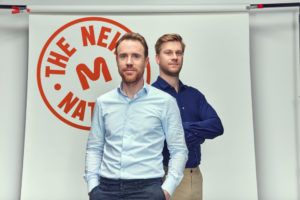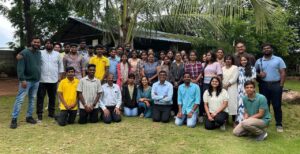Normally, August is a slow month. It wasn’t this year – especially if you’re a seafood startup.
Two big fund announcements and a spate of aquaculture and sustainable seafood deals signal that this long-underinvested agrifoodtech sector has become more than a blip on investors’ radars; it’s now sector with demonstrable and viable investment opportunities.
An exhaustive recap of recent weeks’ aqua-investment activity:
- Mirova, an impact investment arm of the French banking giant Natixis, closed its Althelia Sustainable Ocean Fund at $132 million.
- US-based S2G Ventures closed a $100 million oceans and seafood fund.
- Indian seafood supply chain tech venture Captain Fresh raised $2.3 million in a Series A round led by Ankur Capital.
- Seaweed tech startup Ocean Rainforest, based in the Faroe Islands, secured $1.5 million from investors including the World Wildlife Fund.
- Indonesian fish farm tech provider eFishery completed a Series B round, led by on-demand app Gojek‘s VC arm and Northstar Group.
August’s small deal sizes reflect a still-nascent tech sector. But in case you hadn’t heard, early-stage, deep-tech ventures are having a moment right now, amid a global health and economic disaster that is forcing investors to think longer-term. The number and geographic diversity of these deals is suggestive of the global scale of the opportunity. And the size of Mirova’s and S2G Ventures’ dedicated oceans vehicles hint at a solid and growing investment pipeline in the space.
“The innovation is starting to accelerate, and there are more people at the table now,” said Kate Danaher, managing director at S2G Ventures, who joined the firm from San Francisco impact investor RSF Social Finance to co-lead the new oceans initiative with Larsen Mettler from Seattle-based fish processor Silver Bay Seafoods.
Slow growth
In spite of the two new fund announcements, no one could call aquatech investing an overnight sensation. Mirova’s oceans impact fund, which invests in enterprises and projects that bolster livelihoods and marine health, was launched more than five years ago when Althelia was a separate entity. It took over two years to raise the first $38 million, towards what was then a $100 million goal.
“This is not something that has just popped up,” Mirova’s ‘blue investments’ director Simon Dent told AFN. “[Nobody] had raised this type of money in this area previously. Quite frankly, we had to educate investors.”
S2G’s Danaher agrees. Her firm, which has been invested in sustainable agrifoodtech for the past six years, closed its oceans fund much faster – but that is partly because it began after others like Mirova and Netherlands-based Aqua-Spark had done much of the early education legwork.
“We were looking at this five years ago, and there were very few innovative [technologies] and even fewer dedicated funders,” she said.
Some back-of-the envelope numbers support Danaher’s timeline. Roughly $1.3 billion has been invested in aquatech and seafood-related tech ventures since 2015, growing from just $80 million in 2015 to $445 million last year, according to data from AgFunder [disclosure: AgFunder is AFN‘s parent company.]
Sustainable opportunity
A number of trends are catalyzing investor interest in the sector. For one, startups that have been pioneering new technologies and business models for the past five to seven years are finally proving their markets and showing traction. Sub-sectors related to fish farming, like new feed sources and animal health, are showing a solid pipeline for investors, according to Aqua-Spark investment director Frank van Roest.
“I think more and more people are realizing that fish are also animals and can suffer,” van Roest told AFN. Last November, Aqua-Spark — one of the earliest dedicated aquaculture investors — backed Scotland’s Ace Aquatec, whose range of technologies include humane electric stunners to deter predators, biomass estimation devices, and removal systems for parasites such as sea lice.
Unlike land-based agriculturalists, fish farmers are quicker adopters of new technologies, added van Roest. “Hatcheries are typically high tech and open to new technologies. Also, more developed and consolidated sectors like salmon farming are also high-tech operations.”
Ventures like Portugal’s Oceano Fresco and Mexico-based Mirova investee King Kampachi Company are pushing the bounds, setting up high-tech farms to raise new seafood varieties in open waters. Oceano Fresco is building high-tech clam farms, while King Kampachi is developing sustainable offshore production of longfin yellowtail, a sashimi-quality marine fish that will be marketed to restaurants and retailers in Mexico, Japan, the US, and Europe.
“Ninety-five percent of all ocean aquaculture is salmon,” said Mirova’s Dent. “What we’ve been trying to do is find fish that can be farmed well in tropical waters.”
Sustainable warm-water aquaculture will become increasingly important in the next decade. Global demand for protein is rising, and climate change and over-fishing are increasingly threatening marine ecosystems and the livelihoods of more than 750 million people worldwide.
What comes next
It is perhaps no surprise, then, that much of the early-stage aquaculture and seafood investing that is happening has a strong sustainability focus. Both Mirova’s and S2G’s oceans funds explicitly target sustainability-focused ventures.
Mirova has already made investments through its sustainable oceans fund, backing insect-based fish feed producer NextProtein — which closed a $11.2m Series A round earlier this year to scale up black soldier fly production — and UK-based Safety Net Technologies, which builds devices and sensors that help to increase the selectivity of commercial fishing practices.
It has also made investments in tech companies that have a greater impact on overall ocean health more than the immediate seafood value chain. These include Finland’s Neste, a provider of renewable diesel and jet fuel, and Recycling Technologies, a specialist plastic-recycling tech provider. The latter’s aim, said Dent, is to accelerate the development of chemical recycling so that pollutants don’t end up the world’s oceans.
Mirova’s investment mandate is global in scope, targeting 40% in Latin America and the Caribbean, 30% in Africa, and 30% in Asia Pacific, he added. The focus is on solutions targeting these regions, rather than ones that are necessarily based there.
S2G, too, is hunting for opportunities globally. So far the firm has only one seafood venture in its portfolio: US-based producer FishPeople.
But as August’s deals suggest, many of the new aquatech innovations will come from markets in the global south like India and Indonesia — two of the world’s most populous countries, where animal-based protein consumption is on the rise.
“There are a lot of entrepreneurs out there with great ideas and a great ability to execute, but if they don’t have the capital to support them, they are never going to get their solutions to market,” Danaher said. “Our job is to help build the ecosystem for more funders who want to participate.”




